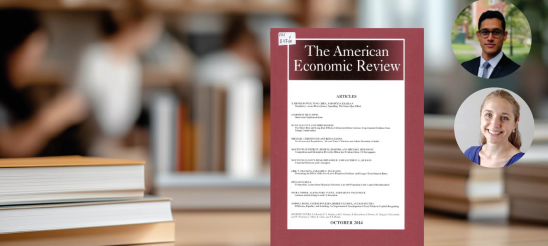We are pleased to announce that Anna Korba, Assistant Professor in Statistics at CREST-GENES, Professor at ENSAE Paris and Hi! Paris affiliated member, has been awarded a prestigious ERC Starting Grant for her research project OptInfinite – Efficient infinite-dimensional optimization over measures.
Launched in 2025 for a 5-year duration, the project aims to develop new optimization and sampling methods over probability measures — a central challenge in artificial intelligence and modern machine learning.
Optimization over probability measures has become an increasingly powerful approach to tackling complex problems involving uncertainty. Unlike traditional methods that work with fixed data points, this framework deals with entire distributions, even in very large or infinite-dimensional spaces.
This is especially useful for sampling tasks, which consist in generating representative examples from a distribution or model. Such tasks are crucial in:
- Bayesian machine learning, where sampling helps quantify uncertainty in model predictions;
- Generative modeling, where it is key to generating realistic new data, such as vectorial data (e.g. images).
However, existing methods often fall short: they are computationally expensive, difficult to evaluate, and poorly suited to high-dimensional or complex distributions. Moreover, they are designed to generate vectorial data, but not more complicated structures such as infinite-dimensional data.
With OptInfinite, Anna Korba aims to overcome these challenges by building a unified theoretical and practical framework, drawing on tools from optimal transport and information geometry. The project will:
- develop more efficient and adaptable sampling algorithms;
- design robust evaluation tools to assess the quality of generated samples;
- deliver an open-source software toolkit to make these methods widely accessible.
The approach will be tested on real-world applications, including large-scale AI models, Bayesian inference, biological systems modeling, and more.
These are fundamental problems in statistics and machine learning, that can be useful in various areas where quantifying uncertainty or when accessible data is scarce, such as finance and economics.
🎧 Curious to learn more about Anna Korba’s background and vision? Check out her interview in our CRESTive Minds series:
👉 Episode 3 – Anna Korba
Quand l’histoire économique éclaire les accord commerciaux
Le 25 août 2024, Béatrice Cherrier, historienne de l’économie, chargée de recherche au CNRS, chercheuse au CREST et professeure associée à l’École polytechnique, est intervenue dans l’émission Entendez-vous l’éco ? sur France Culture.
L’épisode intitulé “Accords commerciaux : que reste-t-il à négocier ?“, revenait sur l’accord commercial conclu cet été entre Donald Trump et Ursula von der Leyen, et interrogeait plus largement les enjeux des négociations transatlantiques. Aux côtés de François Chimits (Institut Montaigne) et de Sylvie Matelly (Institut Jacques Delors), Béatrice Cherrier a apporté un éclairage original en explorant la fabrique de l’expertise économique.
L’apport de l’histoire de l’économie au débat public
Dans son intervention, Béatrice Cherrier a montré comment l’histoire des sciences économiques permet de mieux comprendre la manière dont les modèles et outils mobilisés par les économistes influencent les politiques publiques. Elle a notamment souligné l’importance de prendre en compte les contraintes méthodologiques et techniques qui orientent les choix des experts – par exemple la recherche de modèles “tractables”, c’est-à-dire plus faciles à manier et à résoudre, mais parfois au prix d’une simplification excessive des réalités étudiées.
En mettant en perspective l’évolution de la pratique économique au cours des dernières décennies, Béatrice Cherrier a rappelé que les instruments utilisés aujourd’hui pour analyser les accords commerciaux ne sont pas neutres : ils sont le produit d’une histoire intellectuelle, institutionnelle et technologique qui mérite d’être interrogée.
Un regard CREST sur les enjeux contemporains
La participation de Béatrice Cherrier illustre le rôle actif des chercheurs et chercheuses du CREST dans le débat public. À travers ses travaux, elle contribue à éclairer les grands enjeux contemporains en montrant comment l’économie se construit à l’intersection des idées, des pratiques et des contextes institutionnels.
Cette intervention s’inscrit dans la mission du CREST : produire une recherche de pointe en économie et en sciences sociales, tout en nourrissant la réflexion collective sur les politiques publiques et les grands défis de nos sociétés.
Réécouter l’émission sur France Culture ici.
Our PhD Students on the Job Market – A New Chapter Begins
Every year, a new generation of PhD students completes their journey at CREST and takes their next steps in academia or beyond. This year, several of our doctoral candidates have successfully defended their dissertations and are now preparing to join leading universities and research institutions worldwide.
Their years at CREST have been marked by rigorous research, intellectual curiosity, and strong community ties. We are proud of their achievements and the new perspectives they will bring to their future institutions.
Below, you will find their portraits. By clicking on each photo, you can discover their research, their journey, and their plans for the future.
We warmly congratulate them and wish them all the best in this exciting new chapter!
CRESTive Minds – Federica Meluzzi
Federica Meluzzi – PhD student in economics at CREST-GENES, IP Paris, and research officer at the Ministry of Labour (DARES)
Her research focuses on labor economics, gender, and economics. Her thesis, “The College Melting Pot: Peers, Culture and Women’s Job Search”, was supervised by the economists Arne Uhlendorff and Pierre Cahuc (Sciences Po).
In September 2025, she will begin a post-doctorate at the Department of Economics of Bocconi University in Milan, then, in June 2026, she will join Ludwig Maximilian University (LMU) of Munich as an assistant professor in economics.
1. What have been the key stages of your research journey?
I see my path as an experience of strong personal and professional growth. Several moments were particularly significant. I am thinking in particular of the two visiting periods I had the chance to do, first at the London School of Economics (LSE), then at the University of California, Berkeley (UC Berkeley). These experiences, extremely enriching in every respect, truly reinforced my desire to pursue an academic career after the PhD.
2. What scientific objectives did you set for yourself in the framework of your thesis?
My objectives were simple: to identify important research questions and try to answer them ambitiously, using the best tools and data available.
3. Did the PhD confirm or change your initial professional project?
When I started the PhD, I was quite open regarding my prospects. I had previously worked in international organizations and, at first, I thought I might return there, as I had greatly enjoyed that experience. Over time, the PhD was for me a process of progressive awareness: I discovered that research was a true passion, which gave me the desire to pursue an academic career.
4. What advice would you give to a PhD student at the beginning of the journey?
Think big and enjoy! I don’t know if I am really in a position to give advice, but these are the two principles that guided me throughout my thesis. What also helped me a lot to live this period serenely, especially in the more stressful moments, was to remind myself of the chance I have to be able to do a job that I love, and to keep in mind that difficulties are part of any profession — nothing very specific to the PhD.
5. What guided your interest in this thesis topic and how would you present it in a few words?
I chose to orient my thesis toward the study of inequalities, a subject that is particularly close to my heart as a citizen. Making this question the object of my daily work seemed to me a concrete and satisfying way of contributing to society.
In my thesis, I focus on inequalities between men and women in the labor market, which persist despite decades of progress, notably because of gender norms that remain very entrenched. My research looks at how these norms evolve: for example, how the design of parental leave influences household decisions regarding the sharing of childcare, or how peers met at university influence women’s professional choices.
6. In what way does your thesis go beyond previous research on the persistence of gender norms and, more specifically, on the understanding of the drivers that generate it?
Most existing studies focus either on highlighting the persistence of gender norms across generations, or on the role of the family — especially mothers — in transmitting these norms to women. In my article, I broaden the perspective by studying the influence of the broader social environment, and notably that of peers at university, on the transmission of norms relating to female participation in the labor market.
7. In what way can the Italian context be considered a privileged field for studying the transmission of gender norms in the university environment?
One of the reasons why the transmission of gender norms is still little studied lies in the lack of data or contexts allowing for fine-grained analysis. Italy offers a particularly favorable framework for this type of study, as it presents both strong regional heterogeneity — gender norms and female labor force participation vary considerably from one region to another — and significant student mobility, with many students leaving their home province to study elsewhere. This combination makes university programs very geographically diverse and constitutes an ideal field for understanding to what extent socialization with peers from more or less egalitarian regions influences women’s professional choices.
8. Why are peer effects asymmetrical according to the geographical origins of female students?
One of the main results of the article is that being alongside female students from regions where female labor force participation is higher increases women’s probability of full-time employment and encourages them to move toward better-paying jobs. These peer effects are very asymmetrical: it is especially women from less egalitarian backgrounds who benefit from them. This finding is consistent with a mechanism of social learning: these women revise their initially more pessimistic expectations thanks to the information and experiences shared by their peers from more egalitarian regions.
9. How could your work shed light on the design of more gender-equal public policies? And to what extent can the results of your research be generalized to other countries or cultural contexts?
My study suggests two main avenues for public policies. On the one hand, promoting geographical diversity in higher education, since encouraging regional mix among students could help transform gender norms and promote greater equality between men and women in the labor market.
On the other hand, reducing informational asymmetries: my results show that there are significant differences in access to information depending on women’s geographical origins. Implementing policies aimed at correcting these gaps — for example, through targeted dissemination programs on careers and opportunities — could significantly improve the professional prospects of women from less egalitarian contexts.
10. Do you plan to promote your research beyond the academic framework?
I consider research dissemination to be an essential aspect, to which I would like to devote time in the future. At the risk of being a bit naïve, I believe that spreading scientific results, particularly to civil society, can help improve the quality of democracy. During my PhD, I did not really devote myself to this, as I preferred to focus on my training and on scientific production. But in the future, I clearly wish to reserve part of my time to making my research accessible to as many people as possible.
11. What are your professional prospects, in the short and long term?
I will continue along the academic path. After my PhD, I will do a one-year post-doctorate at Bocconi University in Milan, then I will join Ludwig Maximilian University (LMU) of Munich as an assistant professor. I will certainly continue my research on labor market inequalities, and I also look forward to starting to teach courses on these same topics.
CRESTive Minds – Claire Leroy
CRESTive Minds – Thomas Monnier
CRESTive Minds – Marion Brouard
Marion Brouard – PhD student in economics at CREST, GENES, IP Paris
In September 2025, Marion will join Ifo/LMU Munich as an Assistant Professor.
Her research focuses on public economics and labor economics, with a focus on social insurance programs and labor market inequalities.
Her thesis, “Welfare effects of increasing transfers to young adults: Theory and Evidence”, was supervised by the economists Pierre Boyer and Camille Landais.
1. Within the laboratory, did you benefit from a working environment favorable to the advancement of your research (seminars, working groups, collective research activities)?
For me, CREST has been a wonderful working environment. The research culture there is both very open and caring. There is a lot of exchange and mutual support among PhD students, which creates a real collective dynamic. Professors are also very available and attentive to PhD students. This environment has been for me a constant source of stimulation, with particularly inspiring colleagues. Beyond scientific quality, it is above all the human qualities of the members of the department that made the progress of my thesis more pleasant and serene.
2. Has the subject of your thesis or the orientations of your research evolved since the beginning of your PhD?
When I started my thesis, I thought I would work from beginning to end on a single subject, the one I had proposed when applying. I wanted to focus on young adults, and reflect on fairer social policies capable of reducing inequalities and lowering their poverty rate, which is very high today. This theme has indeed remained at the heart of my thesis. But over time, my perspective broadened, and I gradually became interested in topics that I would not have spontaneously explored at the start, notably those inherent to the labor market. What I appreciated in the framework of the thesis is precisely this freedom: the freedom to explore, to test, to deviate a little, to ultimately better understand what really interests me.
3. Did the PhD confirm or change your initial professional project?
The PhD really transformed my professional project. When I started my thesis, I knew little about the academic world, but I was convinced that I did not want to make a career there. After the thesis, I imagined myself working in public administration. But over the years of the PhD, this certainty gradually faded. I discovered that I found real pleasure in doing research. When the time came to make a choice, I was not yet entirely sure of myself. But I finally decided to embark on an academic career, contrary to what I had imagined at the start.
4. What advice would you give to a PhD student at the beginning of the journey?
Each thesis is different, and everyone experiences it in their own way, depending on their personality, desires, and doubts. But if there is one fairly general piece of advice I could give to someone starting out, it would be to be curious, and to take full advantage of these years to learn as much as possible. Sometimes we feel like we don’t have the time to take courses, attend seminars, or read outside our subject. Yet that time is really important, it nourishes reflection and broadens perspectives — I think it is really necessary to allow oneself that.
I would also say that the PhD is made up of highs and lows. Progress in research is never linear, and that is perfectly normal. It is important to learn not to be too demanding of oneself: the periods when it feels like nothing is working are part of the process, and they in no way reflect the value or abilities of the PhD student.
5. What led you to take an interest in the question of redistribution of social assistance for young adults, and how do you explain the paradox between their high poverty rate and the low percentage of aid they receive?
Young adults are today the most financially fragile age group. Yet they are surprisingly little studied in the economic literature on social assistance. And this paradox goes further: despite their difficulties, the assistance schemes aimed at them remain very limited.
There are several possible reasons for this, but for now, there is a lack of clear research to draw firm conclusions. One of the hypotheses that I find interesting to explore is that there exists a form of ideological bias: policymakers often consider that it is up to parents to support their children, and not the State. But this view has a perverse effect, as it deepens inequalities depending on family resources. And this is clearly visible today in France, where social mobility is among the lowest of developed countries.
6. Your study uses an approach based on “social marginal utility” (SMU). Could you explain this concept? What types of data did you use to estimate social preferences and consumption behaviors?
The objective of this work is to compare the costs and benefits of an increase in social assistance for young adults. In economics, we often speak of “social marginal utility” to designate the social benefits of a policy. Concretely, this corresponds to the individual gain that a beneficiary draws from aid, weighted by the importance that society gives to this gain. For example, if society gives more weight to the well-being of the elderly than to that of young adults, then, for equal individual gains, the social benefit will be higher for the former than for the latter.
To estimate these “social weights,” I carried out a specific survey, since this type of data does not exist in classical sources. As for the individual benefits, I measure them using a well-established approach in economics: I analyze variations in consumption following changes in social assistance. Economic theory shows that the way individuals adjust their consumption in response to a financial shock reflects variations in their level of well-being. Consumption adjustments in response to a financial shock thus make it possible to estimate individual gains. For this, I use very fine data from anonymized banking transactions, which provide a precise measure of the real consumption of young adults.
7. Your results suggest that targeting low-income students would increase the relative effect on well-being eightfold. What changes would this imply in current public policies in terms of redistribution of resources?
Today, the main tool of redistribution for students is scholarships. But these scholarships remain too low: they neither compensate for inequalities linked to parental income nor guarantee decent living conditions for the most precarious students. This is very concrete: even today, one third of young people who stop their studies declare having done so for financial reasons.
Faced with this finding, a first measure would be to increase the amount of scholarships. This reform would have a relatively low cost for the State, as it is in fact a profitable investment. By making it easier to pursue studies, more young people can access better-paid jobs, which, in the long term, increases tax revenues. And above all, the social benefits are clear and very high. This measure would help reduce social inequalities and poverty among scholarship holders, who remain one of the most precarious categories today.
8. How could public policies build on your results to better orient social assistance?
I think my work mainly invites policymakers to profoundly rethink social assistance intended for young adults. What I try to show is that an increase in social transfers for young people would have very strong positive effects.
I also look at a concern often expressed by policymakers: that the State would substitute for the role of financial support from parents. It is a legitimate question, but the data show that this “substitution” mechanism actually remains limited, and above all, that this concern should not be a barrier to the implementation of more generous social policies.
When Managers Choose: Gender Disparities in Employer Training Provision
CREST Working Papers Series No. 2025-10
by Marco Caliendo, Deborah A. Cobb-Clark, Katrin Huber, Harald Pfeifer, Arne Uhlendorff and Sophie Wagner
Unpacking Rising Inequality: The Roles of Markups, Taxes, and Asset Prices
CREST Working Papers Series No. 2025-09
by Stéphane Auray, Aurélien Eyquem, Bertrand Garbinti and Jonathan Goupille-Lebret
Two CREST-Related Publications in the American Economic Review
The August 2025 issue of the American Economic Review (Vol. 115, No. 8) features two articles linked to CREST, highlighting both the strength of our doctoral training and the reach of our research programs.
Randy Kotti, former PhD student at CREST, has published an article based on one chapter of his dissertation “Essays in Political Economy“, defended in June 2023 under the supervision of Pierre Boyer and Jean Ponce.
Keep Your Enemies Closer: Strategic Platform Adjustments during US and French Elections
(co-authored with Rafael Di Tella, Caroline Le Pennec, and Vincent Pons)
This article provides new empirical evidence on how political candidates strategically adjust their platforms between electoral rounds. Drawing on an original dataset of over 9,000 US campaign websites and 57,000 French electoral manifestos (1958-2022), the authors show that candidates converge toward the center and strategically align their discourse with narrowly qualified opponents. The findings offer one of the first direct tests of the Downsian model of electoral competition.
Di Tella, Rafael, Randy Kotti, Caroline Le Pennec, and Vincent Pons. 2025. “Keep Your Enemies Closer: Strategic Platform Adjustments during US and French Elections.” American Economic Review 115 (8): 2488–2528.
Pauline Rossi, researcher at CREST and Full Professor at Ecole polytechnique, also appears in this issue with a publication in the scope of her ERC-funded project P3OPLE (Peers and Possible Partners: exploring the Origins of Population Long-term Equilibria).
The Negligible Effect of Free Contraception on Fertility: Experimental Evidence from Burkina Faso
(co-authored with Pascaline Dupas, Seema Jayachandran, and Adriana Lleras-Muney).
The paper reports on a large-scale randomized controlled trial involving 14,545 households in rural Burkina Faso. Contrary to a widespread assumption, offering free access to modern contraception over a three-year period had no significant impact on fertility rates, even when combined with additional interventions targeting social norms or misperceptions about child mortality. The results challenge the notion that lack of access is the primary barrier to contraceptive use in West Africa.
Dupas, Pascaline, Seema Jayachandran, Adriana Lleras-Muney, and Pauline Rossi. 2025. “The Negligible Effect of Free Contraception on Fertility: Experimental Evidence from Burkina Faso.” American Economic Review 115 (8): 2659–88.
The American Economic Review is one of the world’s most prestigious economics journal, part of the so-called “Top 5”. These two publications reflect the diversity and international visibility of research conducted at or in connection with CREST.








